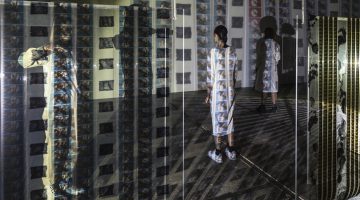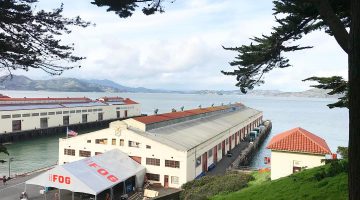
David Goldblatt, Meeting of the worker-management Liaison Committee of the Colgate-Palmolive Company, 1980; gelatin silver print; 19 11/16 x 19 11/16 in. (50 x 50 cm); Courtesy of the artist and Goodman Gallery, South Africa; © David Goldblatt
I didn’t learn about apartheid in grade school; in college, William Kentridge’s animated films inspired some Wikipedia reading, but my understanding of South Africa remained smudgy. This kind of historical lapse isn’t okay, but inclinations inevitably lead to gaps in understanding. Since curiosity is the only solution to humiliating ignorance, I believe in always taking an educational opportunity when it presents itself. Even if it is sure to be crushingly depressing. The San Francisco Museum of Modern Art’s “South Africa in Apartheid and After: David Goldblatt, Ernest Cole, and Billy Monk,” doesn’t give apartheid much context in its wall text. That’s okay, though, because photographers in David Goldblatt, Earnest Cole, and Billy Monk are documentarians and curator Sandra S. Phillips has a gift for visual narrative. (SFMoMA probably also assumes you know apartheid was legislation-based racial segregation in South Africa between 1948-1994.) There are many clues to how the apartheid system worked logistically, (required searches for blacks, segregated transportation), but the show’s educational success hinges on Phillips’ and the photographer’s ability to inspire thoughts that extend beyond the frame.

David Goldblatt, Saturday afternoon in Sunward Park, 1979; gelatin silver print; 6 7/8 x 6 7/8 in. (17.5 x 17.5 cm); Collection SFMOMA, purchase through a gift of Mark McCain and the Accessions Committee Fund; © David Goldblatt

David Goldblatt, An officer of the Voortrekkers, 1980, gelatin silver print, 19 7:8 in. x 19 1:2 in.; Collection SFMOMA, purchase through a gift of Mark McCain and the Accessions Committee Fund; © David Goldblatt
David Goldblatt’s early black and white photographs are divided horizontally or vertically. Metaphors in photography’s formal elements are almost always trite; paneling divides a black man and a white man in “Meeting of the worker-management Liaison Committee of the Colgate-Palmolive Company” (1980), and in “An officer of the Voortrekkers” (1980) a white woman on the frame’s center line is isolated from a sense of humanity. (In this case, the Voortrekkers are a youth organization of Dutch emigrants that were “prepared to deal with the ‘black onslaught’” [Russell, 281]). Even if Goldblatt’s compositional choices are obvious, they’re beautiful. His subject’s facial expressions are psychologically bare—I had a reflexive impulse to imagine the opinions and emotions that led them to whatever racist thought they seemed to be having when Goldblatt shot the photo. Subjects in most images are given sentence-long explanations, with the exception of the prisoner series. Short essays accompany a portrait of a convicted and released rapist or murderer photographed at the scene of their crime. The descriptions of the crimes are factual and without judgment, but I saw in each prisoner how apartheid’s institutional economic or social subjugation contributed to their crimes. It’s strange to feel a woman who strangled her own son to death is circumstantially inculpable.

Ernest Cole, A student who said he was going to fetch his textbook is pulled in. To prove he was still in school he showed his fountain pen and ink-stained fingers. But that was not enough; in long pants he looked older than sixteen., 1960–1966; gelatin silver print; 8 11/16 x 12 5/8 in. (22 cm x 32 cm); Courtesy of the Hasselblad Foundation, Gothenburg, Sweden; © The Ernest Cole Family Trust

Ernest Cole, Africans throng Johannesburg station platform during late afternoon rush., 1960–1966; gelatin silver print; 8 11/16 x 12 5/8 in. (22 x 32 cm); Courtesy of the Hasselblad Foundation, Gothenburg, Sweden; © The Ernest Cole Family Trust
Segregation during apartheid limited each photographer’s access to their own race; David Goldblatt (white) and Earnest Cole (black) are used to inform each other. Thankfully, curator Sandra S. Phillips avoided binaries like black over-crowded train/ affluent white train in favor of photos of more diverse subjects to move the story along; anyway, when looking at the black train by Cole, I reflexively imagined its white counterpart with what I saw in Goldblatt’s photos of a wealthy white home. Cole’s photographs were often shot from a distance, but the subject’s physical pressures (thronged crowd, violent arrest) are palpable to the viewer.

Billy Monk, The Catacombs, 31 July 1967, 1967, printed 2011; gelatin silver print; 11 x 16 in. (27.94 x 40.64 cm); Courtesy of Stevenson, Cape Town and Johannesburg; © Estate of Billy Monk

Billy Monk, The Catacombs, 1968, 1968, printed 2011; gelatin silver print; 11 x 16 in. (27.94 x 40.64 cm); Collection SFMOMA, Accessions Committee Fund purchase; © Estate of Billy Monk
Billy Monk was a bouncer at the Catacombs club in Cape Town, and his excellent snapshots taken in the late 1960’s comprise the exhibit’s only examples of interracial fraternization during apartheid (which was, in fact, illegal). After the weight of Goldblatt and Cole’s subjects, seeing the bond between an Asian man and white woman is heartwarming—even if that bond is based on getting pass-out drunk.
“South Africa in Apartheid and After: David Goldblatt, Ernest Cole, and Billy Monk” is on view at the San Francisco Museum of Modern Art through March 5, 2013.
-Kendall George
Citation:
Russell, Diana E. H.. Lives of Courage: Women for a New South Africa. Basic Books (June 1991): 281. Images via SFMoMa.


